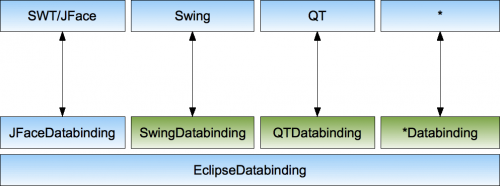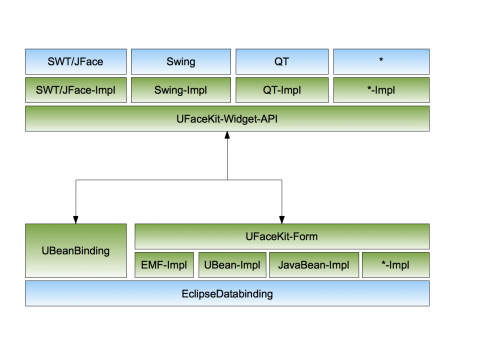Notice: this Wiki will be going read only early in 2024 and edits will no longer be possible. Please see: https://gitlab.eclipse.org/eclipsefdn/helpdesk/-/wikis/Wiki-shutdown-plan for the plan.
UFaceKit
UFaceKit is a project providing an high-level, widget toolkit independent UI-API ranging from SWT over GWT to potentially Android.
The project can currently be split into 2 main working areas
- The Core Modules
- The Technology-Specific Modules
which itself once more split into smaller sub-areas
Contents
Overview
UFaceKit works on different levels using a layered setup first and fore most UFaceKit needs to have an Eclipse-Databinding for Widget and Model-Technologies it wants to use. Some of them are provided by other projects (SWT-Observable, EMF-Observables) and UFaceKit reuses them. For other technologies it provides the implementation as part of the UFaceKit project.
On top of this enabling bits UFaceKit provides higherlevel APIs for easier use
and built-in support for advanced features like:
- declarative styleing (e.g. using CSS)
- declarative ui definition using Ecore
- automatic decoration support
- ...
The Modules
The Core Module
The core modules of UFaceKit define the common ToolKit-Independent UFaceKit-API and features like styling and JavaScript expressions. A detailed description of the modules can be found here.
The Technology-Specific Module
Modules in this section hold technology specifc implementations from generic APIs ranging from UFaceKit-API to Databinding-API for example IObservable implementations for Swing-Controls.
Development
Contributing to UFaceKit
- Setting up within Eclipse
- Setting up using Maven
Consuming UFaceKit
Examples Codes
We have a set of Example applications you can take a look at to get started. They exploit all features provided by UFaceKit and you can learn how the we expect UFaceKit to work
- Addressbook-Example: Small example showing usage of EMF and Declarative Styling
- ... hopefully more in future ...


